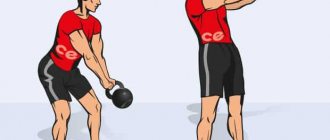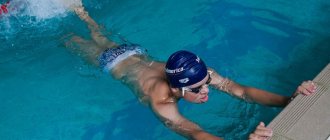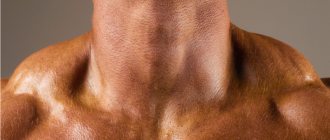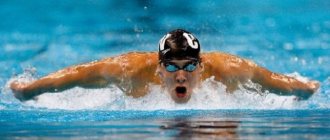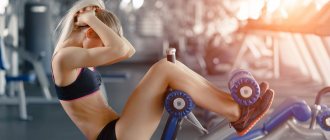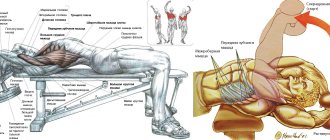Hello my dear readers!
One of the areas of sports swimming is breaststroke. How to really learn to swim and what kind of technique this sport has - we will talk about this later.
Breaststroke swimming is carried out as follows:
- The arms make a stroke towards themselves and then rush forward. Due to the stroke, the shoulder girdle and head rise above the water, an inhalation is made, then while pushing the arms forward, the head falls into the water.
- During the throwing of the arms, the legs make a push, which resembles the movement of a frog.
Breaststroke rules
The rules state that for this style, the swimmer lies on his chest with his shoulders in a line parallel to the surface of the water and perpendicular to the front of the movement. Both hands move simultaneously and symmetrically.
Rowing is carried out with a horizontal spread of arms to the sides. In this case, the arms are spread out to the sides, moved back, bent over the elbows and extended forward on the surface of the water or under water.
Leg movements must be simultaneous and symmetrical. At every moment of movement, the feet and knees should be in a horizontal plane, respectively. The legs are bent, spread and then connected.
After the start and turns to keep the swimmer on the surface under water, he is allowed to make breaststroke swimming movements with his legs and arms. Full immersion of the head under water is not allowed, with the exception of sliding after launching and turning. The number of relationships between the movements of the arms and legs is arbitrary
During turns and at the end, the swimmer touches the walls of the pool with both hands at the same time, with horizontal shoulders.
Useful tips
If you decide to take up breaststroke swimming, we recommend that you:
- Before entering the pool, practice on the bench . This will give you an idea of how to coordinate your movements and how synchronized they are.
- Learn to hold your breath . To do this, immerse your head under water and exhale without interruption in accordance with the breathing technique described above.
- Train the dive . Dive under the water, stay in this position for a few seconds and quickly rise to the surface, at the same moment quickly inhaling and exhaling.
- Use fins . They will help you learn to stay stable in the water.
- Relax . After training, reduce the load on your muscles. To do this, simply swim at a slow pace for a while.
By adhering to the recommendations given in the article on the movements performed and breathing patterns, you can easily learn to swim in the breaststroke style. Don’t forget about training exercises and avoid mistakes - and quick results are guaranteed.
Benefits of swimming
Swimming breaststroke brings significant benefits to the body:
- Breaststroke swimming technique requires proper breathing, which helps stimulate and strengthen the respiratory system and lung development.
- Prolonged contact with the aquatic environment has a massage effect on the skin of the body, improves blood circulation in internal organs, and also helps cleanse the skin.
- Active blood circulation, which begins during swimming exercises, completely eliminates stagnation of blood and other water in the body, and also helps strengthen the walls of blood vessels and the heart.
- Constant contact with water helps strengthen the immune and nervous systems, improves mood and relieves stress.
- In half an hour, swimming breaststroke, the body will expend about 270 calories of energy, which is significantly higher than any other sports exercise.
- Breaststroke helps strengthen muscle groups such as the shoulders, arms, abdominals, buttocks and thighs.
- Breaststroke has a positive effect on your posture and movements: they become smooth and graceful.
- Breaststroke is great for pregnant women: it strengthens the muscles of the groin and legs, which can make childbirth easier in the future.
Benefits and harms
Swimming itself brings enormous benefits for the development of the entire body. And when using the breaststroke technique, all major muscle groups are involved.
- Correct breaststroke completely relieves the spine, which allows people with musculoskeletal problems to swim.
- Develops endurance and overall level of physical activity.
- Aligns posture.
- Swimming uses up a lot of energy, which helps you lose weight.
- During swimming, the functioning of the kidneys, liver, and excretory system improves.
- The respiratory and cardiovascular systems develop.
- Swimming eliminates congestion in the pelvic area, which has a beneficial effect on the potency of men and the reproductive systems of women.
There are no disadvantages to swimming, unless the swimmer has contraindications:
- active asthma;
- heat;
- chronic diseases in the acute phase;
- respiratory tract diseases;
- abdominal operations in the recent past.
The breaststroke technique is ideal for dealing with unexpected situations on the water. The swimmer may move slowly, but he is capable of covering long distances. You can swim with your clothes on, resist high waves, and still have an excellent view in front of you.
You can swim breaststroke with one active hand, if you have to hold the victim or some object with the other. You can tow small objects in front of you by pushing it before the first phase of movement.
Body position
The body is located horizontally along the surface of the water. Lie on the water with your star side down, then bring your legs and arms together. Stay in this position for as long as possible. This exercise helps a person gain confidence in the water.
First, the body is fully straightened, arms extended forward, legs closed, head immersed in water (in the shape of a “torpedo”). As the arms make a raking motion, the head comes out of the water and an inhalation is made (cobra shape).
So, the body takes on the shape of a “frog” - the knees are twisted, the heels tend to the buttocks, the legs are lined up, the hands are under the chest. The narrow legs make sudden movements, the arms, having finished running, straighten, the head lowers into the water, exhale. The body is completely straight again.
No delays allowed
Don't hold your breath!
Many swimmers intuitively want to hold their breath under water - so that there is enough air in their lungs longer, and in order to better stay on the water.
Under no circumstances should this be done - exhalation must begin immediately, without any delay:
- Firstly , constant holding of breath leads to the fact that carbon dioxide begins to accumulate in the lungs and circulatory system. Because of this, rapid fatigue sets in, including fatigue and dizziness.
- Secondly , the so-called buoyancy leads to an incorrect position of the body : it should be positioned as horizontally as possible (chest and legs in the same line), and if you have a large air sac in your chest, then it is pulled more strongly upward, and the pelvis and legs - downward, the body strives to take a vertical position.
Therefore, this “buoyancy” can only help someone who cannot swim to stay on the water, but it only harms the correct horizontal position of the body.
Breath
In the final stage, the circular motion of the arms gently pushes the body upward as the arms begin to converge on the chest. The head rises and breathes. When the “sticky” palms cut through the water, the face drops. Exhalation is performed in water through the nose.
Correct breathing should be uniform. Don’t rush to breathe, even better, inhale and exhale evenly and slowly. Find a normal rhythm for your breathing.
You can practice without leaving your computer. Stand up and try to combine the movements of your arms with your inhalations and exhalations.
Why do you need to be able to swim?
I have friends who can’t swim and when asked “Why?” They answer: “Why do I need this?” It happens that a person who did not learn to swim as a child avoids bodies of water for the rest of his life. Such an attitude in an adult can develop into a real fear of water spaces, which interferes with leading a normal life: relaxing on the beaches, swimming in the pool, etc.
Such people cannot experience what it is like to move in water, but also risk death in a dangerous situation. This is not to mention the benefits that swimming provides as a sport, fitness, and even, in a sense, a massage for the whole body.
Advantages and disadvantages
Let's start with the advantages of breaststroke:
- Allows you to cover long distances with low loss of strength.
- The best aerobic workout for the body, an excellent alternative to running, cycling, etc.
- Minimum load on joints.
- Helps you lose weight. A man weighing about 70 kg burns more than 700 calories in an hour of breaststroke.
- The condition of the spine improves and posture is corrected.
- Breaststroke swimming does not require much physical effort, so it is well suited for girls and women.
- The whole body is trained, the respiratory system develops.
The only negative that I can highlight is the swimming technique. It will be difficult for beginners to immediately master this style. It requires knowledge of technique and the ability to stay in the water, which will require additional training.
Synchronicity
IMPORTANT: movements should not be sudden.
The main task: synchronization of movements and breathing in general, leading to automatism. Straightening the subject's crooked legs should occur immediately with the arms closed forward. The body is fully straightened, the face is lowered into the water - this gives a very fast movement when pushing with the legs.
Bugs in the pool
- Swimming with your head up. This is perhaps the most serious and harmful mistake - you not only slow down your progress, depriving your body of the aforementioned sliding, but also overload the cervical spine, which can lead to injuries and diseases.
- Raising the knees to the sides. It is a mistake to spread your knees to prepare your legs for kicking, as shown in this illustration:
They should be closed both at the moment of pulling the legs and at the moment of spreading the feet - and only at the moment of impact do the legs straighten and the knees, accordingly, diverge. - A weak kick with your feet. Proper foot technique means that he must be strong and sharp .
- General incoordination of movements. Coordination of movements, as stated, is the most important thing in breaststroke technique. If you push your legs too early or too late, all the effectiveness of this style will be lost.
- Hands do not cling to the water and do not rake it. Hands should not just move in the water, but rather lean on it and rake it. This error is shown in the illustration below:
- Putting your hands behind your back. During the stroke, the arms should reach the shoulder line and then be thrown out. If you bring them too far, then, on the one hand, the stroke will be more powerful, but at the same time it will be more difficult to return, and the effectiveness of the technique will decrease.
Swimmer's turns
The swimmer turns during the breaststroke race according to FINA rules, the athlete must immediately touch the edge of the pool with both hands. To increase speed, swimmers touch the side during the upper limb recovery phase, or the phase in which they glide underwater. Then the legs touch the side, the person turns on his side.
At this time, one of the shoulders is pulled forward along the body. The other hand makes a turn, reaching the one that went to the front. The body must be turned completely or partially horizontally under water.
When all parts of the human body are below the water level, it is necessary to push to the side with both feet. Then there is sliding under the surface of the water, swinging the lower limbs, sliding a little more and ascending to the top.
Swimmers' mistakes when swimming on the front
Strongly pulling the knees towards the chest. Because of this error, the water flow rests against the knee and the speed decreases. Correctly pull your heel towards your butt.
Unchanged body position. At the beginning of the breaststroke, the upper part of the body goes under the water a little deeper, during the surface it rises slightly above the water, and during the slide it remains parallel to the water.
Quick leg lift. To push off strongly and give your body good acceleration, you need to smoothly pull your legs towards you and then push off sharply. During quick pull-ups and sharp pushes, the legs do not accelerate, but only become exhausted.
Lack of symmetry in movements. If the legs move asymmetrically, the pelvis and back will be distorted, pain will appear, and speed will decrease.
Incorrect kick. The push occurs with the L-shaped foot, as if it is turned outward. Many people make the mistake of using the freestyle push method.
Lack of legs. After a technical push, the legs are straightened and brought together, the feet are connected. If this does not happen, the acceleration will disappear.
Leg movements
Leg movements during breaststroke swimming can be divided into three phases: pull up, push off and slide.
Pull-up: The swimmer bends his legs at the hip and ankle joints and moves his knees to the sides. When the pull-up is completed, the legs are pushed out to the sides for push-off.
Push-off: performed through vigorous extension of the legs at the hip and knee joints. During the push-off, the athlete, so to speak, rests on the water with the inner surface of the lower leg, leg and foot. The legs and feet make wide movements. The push-off phase ends with straightening your legs and pointing your toes out.
Sliding: After pushing off, the swimmer slides forward.
Interesting history and health effects
The longest distances in marathon swims are done with breaststroke. This is one of the oldest swimming techniques, mastered by people at the dawn of civilization. There are mentions of it in rock paintings and the earliest manuscripts. This style was used to swim almost 10,000 years ago. At the beginning of the 20th century it became an Olympic sport.
Interesting history and health effects
The use of the brace style is possible even for people who have undergone operations and have various diseases that do not allow them to engage in any other sport. When swimming, a person does not have an additional load on the spine and individual muscle groups, which does not provide contraindications for exercise for many people with health conditions.
Perseverance and hard work will help when learning to swim breaststroke on your own. It is important to study and train each movement until it becomes automatic, while setting a goal for each lesson and achieving it. The body must remember all the exercises and perform them efficiently and energetically. The clarity and completeness of each action will be a component of the entire process until the desired result is achieved.
How to learn
Adults
If you are an adult and want to master this style, we recommend the following method of action:
- Master footwork separately.
We imitate their movements on land, so we take a swim board that will keep us afloat and isolate our arms, and we float only by kicking. The more distance we accumulate, the better the result will be.
- Hand work is mastered separately.
Here we isolate our legs, holding a stick between them, and learn how to make strokes.
Synchronization
We begin to swim in full coordination. The goal is to synchronize the movements of all limbs so that the thrust of the arms forward is carried out immediately with the striking movement of the legs.
At first, you can build a distance in full coordination - in general, to feel all the movements and get used to them.
How to breathe properly while swimming breaststroke?
Features of inhalation include several points:
- As soon as you raise your head above the water, take a sharp breath through your mouth, but not through your nose.
- Along with the head, the shoulder girdle also rises.
- An undulating movement performed using the neck that makes swimming more efficient. The essence of it is to make a surfacing movement, and then dive back under water.
the exhalation technique without difficulty:
- Exhale through your nose when you are underwater. If you are swimming very fast and simply do not have time to exhale everything, then you do it with both your nose and mouth.
- Exhale as you throw your arms out and push off with your legs. It will last throughout the synchronized movement and will end exactly at the moment when you need to inhale.
To quickly get used to breaststroke breathing, do special training before each swim. Lower your face under the water and take 5-10 exhalations through your mouth and then through your nose.
Pay attention to the image that shows inhalations and exhalations during different movements:
Detailed description
As mentioned above, in addition to the most key ones, more than 20 different muscles are involved in this method of swimming.
Here's a nice animation where you can see how most of them work :
Now we present a detailed list of them in relation to different parts of the body.
Front of the body and neck
Chest, stomach, neck work:
- Chest muscles (upper part);
- Lateral muscles (serratus anterior);
- Oblique and rectus abdominis muscles;
- Neck – sternocleidomastoid muscle.
Back
Latissimus dorsi
The main part of the back muscles is involved:
- Latissimus dorsi muscle;
- Trapezoid;
- Erector spinae muscle;
- The teres major and minor, as well as the rhomboid major and minor muscles.
Shoulders and arms
The following muscles are used in the upper part of our body:
- Deltoid;
- Brachioradial;
- Biceps (not much, but works);
- Triceps (similar);
- Flexor digitorum profundus;
- Muscles of the palm.
Lower body and legs
Again, many muscles are involved:
- Quadriceps (quadriceps);
- Gluteus maximus;
- Large, adductor of the thigh;
- Double-headed;
- Gastrocnemius;
- Anterior tibial;
- Muscles of the foot.
The structure of the leg muscles


